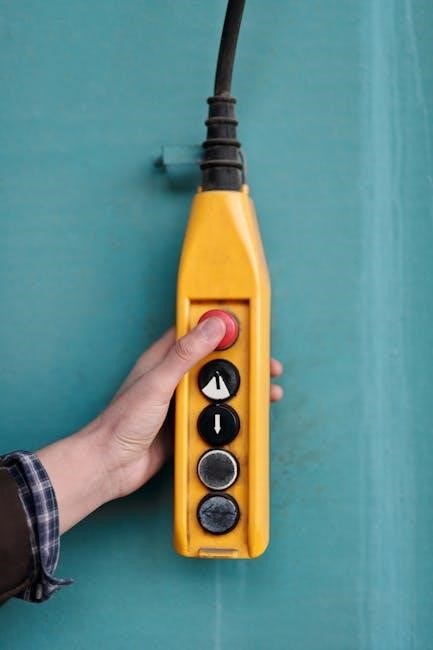Battery-operated Howard Miller clocks combine precision engineering with elegant design, offering reliable timekeeping with minimal maintenance. These clocks use quartz movements, ensuring accuracy and durability. Perfect for modern spaces, they blend traditional craftsmanship with contemporary convenience, providing a hassle-free timekeeping experience.
Overview of Howard Miller Clocks
Howard Miller clocks are renowned for their exceptional craftsmanship and timeless designs. Offering a variety of styles, including floor, wall, and mantel clocks, they cater to diverse home decor preferences. Known for their precision and durability, these clocks feature high-quality materials and intricate details. Battery-operated models simplify maintenance, relying on reliable quartz movements for accurate timekeeping. Essential components like pendulums and weights ensure smooth operation, while manuals provide guidance for specific models, enabling owners to maintain their clocks effectively and preserve their functionality over time.
Importance of Proper Maintenance
Proper maintenance is crucial for preserving the beauty and functionality of your Howard Miller clock. Regular care ensures the clock’s mechanisms operate smoothly, maintaining its accuracy and extending its lifespan. Dust accumulation can hinder movement, while neglecting battery care may lead to timekeeping issues. By following the manual’s guidelines, you can prevent damage, keep the clock looking pristine, and ensure it remains a reliable timepiece for years to come. Consistent upkeep also protects your investment in this high-quality clock.
Maintenance and Care of Your Howard Miller Clock
Regular maintenance ensures your Howard Miller clock remains precise and elegant, requiring simple steps like dusting and battery checks to preserve its functionality and appearance.
Steps to Maintain Quality and Functionality
To maintain your Howard Miller clock’s quality and functionality, ensure proper setup, regular battery checks, and gentle cleaning. Avoid harsh chemicals and extreme temperatures. Dust surfaces with a soft cloth and inspect the pendulum for stability. Refer to the manual for specific guidance, and address any issues promptly to preserve accuracy and longevity. Regular maintenance ensures your clock remains a reliable and elegant timekeeping companion.
Cleaning and Dusting Techniques
Regular cleaning ensures your clock remains pristine. Use a soft, dry cloth to gently wipe surfaces, removing dust and fingerprints. Avoid harsh chemicals or abrasive materials that could damage finishes. For intricate carvings or ornaments, use a clean, small-bristle brush. Never expose the clock to excessive moisture, as it may harm internal components. Periodically inspect the clock’s exterior and mechanics to maintain its functionality and aesthetic appeal. Proper cleaning preserves both the clock’s beauty and its precise timekeeping abilities over time.
Handling and Storage Best Practices
Handle your Howard Miller clock with care to avoid damage. Always lift the clock securely, supporting the base and top to prevent shifting or tilting. When storing, place the clock in a protective box or bag to safeguard against dust and scratches. Position it upright to maintain balance and stability. Avoid exposing the clock to extreme temperatures or humidity, as this may affect its mechanism. Clean the clock gently with a soft cloth before storing to prevent dirt buildup. Remove batteries if storing for extended periods to prevent leakage.
Understanding the Battery Operated Mechanism
Battery-operated Howard Miller clocks use a quartz movement powered by a battery, ensuring accurate timekeeping; The mechanism is designed for low maintenance and reliable performance, requiring only periodic battery replacement to function seamlessly.
How Battery Operated Movements Work
Battery-operated Howard Miller clocks utilize a quartz movement, powered by a battery, to ensure precise timekeeping. The battery sends energy to a quartz crystal, which vibrates at a consistent frequency, driving the gears to move the clock hands accurately. This mechanism eliminates the need for winding, making it low-maintenance and reliable. The battery typically lasts for several years, providing uninterrupted operation. This energy-efficient design ensures the clock functions seamlessly without external power, making it a practical choice for everyday use.
Choosing the Right Battery Type
For battery-operated Howard Miller clocks, selecting the correct battery type is essential for optimal performance. Typically, these clocks require either AA or AAA alkaline batteries, known for their reliable and stable power supply. Alkaline batteries are recommended due to their consistent voltage and longevity. While lithium batteries offer extended life and better temperature resistance, alkaline batteries are generally sufficient unless specified otherwise. Always opt for high-quality batteries to ensure accurate timekeeping and avoid potential damage. Prior to replacement, consult the manual for specific guidelines to maintain your clock’s functionality and longevity.
Replacing Batteries Safely and Effectively
To replace the batteries in your Howard Miller clock, first locate the battery compartment, typically accessible through the back panel. Ensure the clock is turned off to prevent damage. Use a screwdriver to open the compartment if necessary. Remove the old batteries carefully and dispose of them properly. Insert the new batteries, ensuring they are seated correctly and the terminals are aligned. Avoid mixing old and new batteries or using damaged ones. Once replaced, close the compartment securely. Turn the clock on and verify it operates smoothly. Always consult the manual for specific instructions to ensure safe and effective replacement.

Instruction Manuals for Howard Miller Clocks
Howard Miller provides comprehensive manuals for their battery-operated clocks, detailing setup, maintenance, and troubleshooting. These guides ensure optimal performance and longevity of your timepiece.
Locating the Correct Manual for Your Clock
To find the right manual for your battery-operated Howard Miller clock, visit their official website or contact customer support. Manuals are organized by model number or product type, ensuring quick access. Enter your clock’s specific details to download the precise guide. This resource is essential for understanding operation, maintenance, and troubleshooting, helping you keep your clock functioning optimally. Accurate information guarantees proper care and longevity of your timepiece.
Key Features of the Instruction Manual
The instruction manual for your battery-operated Howard Miller clock is a comprehensive guide, providing detailed setup instructions, maintenance tips, and troubleshooting solutions. It includes step-by-step directions for initial configuration, syncing with radio-controlled signals, and manual time adjustments. Additionally, the manual covers care techniques to preserve the clock’s appearance and functionality. Troubleshooting sections address common issues, while warranty information ensures support when needed. Clear diagrams and concise language make it easy to follow, ensuring your clock runs smoothly and retains its elegance for years to come.
Troubleshooting Common Issues
Common issues with battery-operated Howard Miller clocks include incorrect time settings or poor signal reception. If the clock fails to sync, ensure it is in an area with strong radio-controlled signal reception. For manual adjustments, move only the minute hand counterclockwise to avoid damaging the mechanism. If the clock stops operating, check the battery installation and ensure it is the correct type. Refer to the manual for specific troubleshooting steps tailored to your clock model, ensuring optimal performance and longevity of your timepiece.

Setting Up Your Howard Miller Clock
Setting up your Howard Miller clock involves precise initial configuration to ensure accurate timekeeping. Follow the manual’s guidance for syncing with radio-controlled signals or manual adjustments for reliable operation and proper functionality over time.
Initial Setup and Configuration
Initial setup involves installing the batteries and setting the time accurately. Insert the recommended battery type, ensuring correct polarity to avoid damage. Set the time by moving only the minute hand counterclockwise to align the hour and minute hands properly. This method prevents internal mechanism damage. Once set, the clock will operate smoothly, maintaining precise timekeeping. Always refer to the manual for specific instructions tailored to your clock model to ensure optimal performance and longevity. Proper configuration is key to reliable functionality.
Syncing with Radio-Controlled Time Signals
Howard Miller radio-controlled clocks automatically synchronize with the WWVB time signal, ensuring accurate timekeeping. During initial setup, the clock will search for the signal, which may take a few minutes. For optimal reception, place the clock near a window or away from obstructions. If syncing is delayed, move the clock to an area with a clearer signal. Once connected, the clock will adjust to the correct local time automatically, providing precise timekeeping without manual intervention. This feature eliminates the need for frequent time adjustments, enhancing convenience and reliability.
Adjusting Time Manually
To manually adjust the time on your Howard Miller clock, locate the time-setting dial on the back. Move ONLY THE MINUTE HAND counterclockwise (backwards) until the hour and minute hands align with the desired time. Avoid moving the hour hand directly, as this can cause damage. Once set, the clock will maintain accurate timekeeping. This method is straightforward and ensures precise time adjustment without affecting the clock’s internal mechanism. Always handle the hands gently to prevent damage and maintain the clock’s reliability. Follow this procedure carefully for optimal performance.
The Role of Pendulum and Weights
The pendulum regulates timekeeping accuracy, while weights power mechanical movements in select Howard Miller clocks. Together, they ensure smooth operation and precise timekeeping, enhancing the clock’s functionality and aesthetic appeal.
Understanding Pendulum Functionality
The pendulum in Howard Miller clocks plays a crucial role in regulating timekeeping accuracy. It swings back and forth, dividing time into equal parts, ensuring consistent movement. For battery-operated models, the pendulum is often powered by the movement, enhancing the clock’s traditional appeal. Adjusting the pendulum’s length or weight can fine-tune accuracy. Proper alignment and stability are essential for optimal performance. Regular inspection ensures the pendulum operates smoothly, maintaining precise timekeeping and preserving the clock’s heritage of craftsmanship and reliability over time.
Adjusting Weights for Accurate Timekeeping
Adjusting weights in your Howard Miller clock ensures precise timekeeping. Weights are designed to power the clock’s mechanical movement, and their balance is critical. To adjust, gently move the weights upward or downward to achieve proper alignment. Ensure the clock is level and stable before making adjustments. Over-tightening or misalignment can affect accuracy. Regular inspection and minor tweaks will keep your clock running smoothly, maintaining its reliability and timeless appeal for years to come.
Maintaining Pendulum Stability
Maintaining pendulum stability is crucial for accurate timekeeping in battery-operated Howard Miller clocks. Ensure the clock is placed on a level surface to prevent uneven swinging. Avoid exposing the clock to vibrations or extreme temperatures, as this can disrupt the pendulum’s rhythm. Gently adjust the pendulum’s position if necessary, ensuring it swings freely without obstruction. Regular inspection and minor adjustments will help maintain consistent timekeeping and preserve the clock’s mechanical integrity over time.

Accessing the Clock Movement
Accessing the clock movement involves opening the back panel, often secured with screws or clips. Use tools carefully to avoid damaging internal components or chimes.
How to Open and Access the Back Panel
To access the clock movement, locate the screws or clips securing the back panel. Remove them using a flathead screwdriver. Gently pry the panel open, taking care not to damage internal components or chimes. Once open, you can inspect and adjust the movement, pendulum, or weights as needed. Always handle the movement by the edges to prevent damage. Refer to your manual for specific instructions tailored to your clock model, ensuring safe and effective maintenance.
Inspection and Adjustment of Internal Components
Inspect internal components carefully to ensure proper function. Check the pendulum for alignment and stability, ensuring it swings freely. Examine the battery compartment for secure connections and verify the movement is clean. Gently remove dust using compressed air or a soft brush. If necessary, adjust the timekeeping accuracy by tweaking the pendulum or weights. Always handle components with care to avoid damage. Refer to your manual for model-specific adjustments, ensuring all internal parts align with manufacturer guidelines for optimal performance.
Reassembling the Clock After Maintenance
After completing internal inspections or adjustments, carefully reattach all components in the reverse order of disassembly. Replace the back panel securely, ensuring all screws are tightened evenly. Reattach the pendulum and weights, aligning them properly for balanced operation. Gently swing the pendulum to verify smooth motion. Double-check that all parts are firmly secured and functioning correctly. Finally, test the clock by observing its timekeeping accuracy and ensuring all chimes or sounds operate as intended. Proper reassembly ensures optimal performance and longevity of your Howard Miller clock.
Quartz Clock Movements
Howard Miller quartz clock movements offer exceptional accuracy and reliability, powered by batteries. They require minimal maintenance and eliminate the need for winding, ensuring precise timekeeping.
Advantages of Quartz Movements
Quartz movements in Howard Miller clocks provide exceptional accuracy, reliability, and low maintenance. They eliminate the need for winding, ensuring consistent timekeeping with minimal effort. Battery-operated quartz movements are energy-efficient, offering long battery life. These movements are resistant to environmental factors like temperature changes, making them highly durable. Their sleek design and precise engineering ensure smooth operation, making them ideal for both traditional and modern clock styles. Quartz movements are a cornerstone of Howard Miller’s reputation for quality and performance.
Specific Instructions for Quartz Clocks
For Howard Miller quartz clocks, insert the battery correctly, ensuring the positive terminal faces inward. Avoid touching internal components to prevent damage. To set the time, move ONLY the minute hand counterclockwise until the correct time is reached. Never force the hands backward, as this can damage the mechanism. Use the provided adjustment tools if necessary. Keep the clock away from extreme temperatures and humidity. Replace batteries annually or when the clock stops. Regularly clean the exterior with a soft cloth to maintain its appearance and functionality.
Common Issues and Solutions
Common issues with Howard Miller quartz clocks include stopping, incorrect timekeeping, or faulty chimes. If the clock stops, check the battery and ensure it’s installed correctly. For timekeeping errors, adjust the minute hand counterclockwise to set the time accurately. If chimes malfunction, inspect for obstructions or misaligned hammers. For radio-controlled models, poor signal reception can cause inaccuracies; move the clock to a location with better signal strength. Regular cleaning and avoiding extreme temperatures can prevent many issues, ensuring optimal performance and longevity of your Howard Miller clock.
Wall and Mantel Clocks
Howard Miller wall and mantel clocks are designed for elegant spaces, offering precise timekeeping with minimal effort. Their battery-operated mechanisms ensure reliability and low maintenance, blending seamlessly into modern or traditional decor, while providing accurate and dependable performance for years to come.
Installation and Mounting Tips
Mounting your Howard Miller wall or mantel clock requires careful planning to ensure stability and proper timekeeping. Choose a sturdy wall location, avoiding direct sunlight, which can cause fading or temperature fluctuations. Use a level to ensure the clock hangs straight, and select a spot where the clock is easily visible. For mantel clocks, place them on a stable, level surface. Secure the clock firmly to the wall using the provided hardware or a sturdy hook. Avoid over-tightening screws to prevent damage. For added stability, ensure the clock is centered and evenly balanced. Regularly check the mounting hardware to prevent loosening over time.
Leveling the Clock for Proper Function
Proper leveling is crucial for the accurate operation of your Howard Miller clock. Use a carpenter’s level to ensure the clock is perfectly horizontal. For wall clocks, adjust the mounting hardware to align the clock face straight. If necessary, use shims or adjust the hanging mechanism to achieve balance. For mantel clocks, place them on a level surface and check alignment. Ensure the clock’s face is parallel to the ground. This prevents uneven weight distribution and ensures smooth movement operation. Regularly verify the clock’s alignment to maintain optimal functionality and accuracy.
Securing the Clock to Prevent Damage
To prevent damage, ensure your Howard Miller clock is securely fastened. For wall clocks, use the provided mounting hardware and check weight limits. Mantel clocks should be placed on a stable, flat surface away from edges. Consider using anti-tip brackets for added stability. Regularly inspect the clock’s position to ensure it remains level and secure. Avoid exposing the clock to extreme temperatures or humidity. By properly securing your clock, you protect it from accidental falls and ensure long-term functionality and aesthetic appeal.

Floor Clocks
Floor clocks by Howard Miller are statement pieces, combining timeless design with precise engineering. They require careful assembly and placement to ensure stability and accurate timekeeping.
Assembly and Placement Guidelines
Proper assembly and placement are crucial for floor clocks. Follow the manual to ensure all components are securely attached. Place the clock on a level surface, away from direct sunlight and moisture. Avoid areas with extreme temperatures or humidity. Ensure the clock is stable to prevent tipping. Use the provided leveling feet to adjust the base for even balance. Once assembled, move the minute hand counterclockwise to set the time accurately. Secure the clock to the wall if necessary, especially in homes with children or pets, to prevent accidental damage.
Adjusting the Pendulum for Floor Clocks
For accurate timekeeping, the pendulum must be properly adjusted. Gently move the pendulum left or right to set the correct time. Ensure the clock is level and on a sturdy surface. Avoid direct sunlight or vibrations, as they can affect performance. The pendulum’s swing should be smooth and consistent. Adjustments may be needed periodically to maintain precision. Refer to the manual for specific instructions, as improper adjustment can lead to timekeeping errors. Proper alignment ensures reliable operation and extends the clock’s longevity.
Maintaining Floor Clock Stability
Maintaining stability is crucial for floor clocks to ensure accurate timekeeping. Place the clock on a level, sturdy surface to prevent wobbling. Use felt pads under the legs to protect flooring and enhance stability. Avoid placing the clock near direct sunlight or heat sources, as this can warp the wood. Regularly check and tighten loose parts, and ensure the clock is securely anchored to the wall to prevent tipping. Proper stability ensures smooth operation and prolongs the clock’s lifespan. Always refer to the manual for specific stability recommendations.
Radio-Controlled Clocks
Howard Miller radio-controlled clocks automatically synchronize with WWVB time signals, ensuring precise accuracy. They adjust to local time zones and daylight saving changes effortlessly, maintaining flawless timekeeping.
How Radio-Controlled Clocks Work
Radio-controlled Howard Miller clocks receive time signals from the WWVB radio station, ensuring precise synchronization. The clock decodes the signal to set the correct time automatically, adjusting for time zones and daylight saving changes. This technology eliminates manual adjustments, providing accurate and reliable timekeeping without user intervention. The clocks are pre-programmed to interpret the signals, making them a convenient choice for maintaining accurate time effortlessly.
Setting Up Radio-Controlled Time Signals
To set up radio-controlled time signals on your Howard Miller clock, ensure it is placed away from electronic interference. The clock automatically tunes into the WWVB signal, typically within 24 hours. For quicker setup, position the clock near a window, preferably at night, as signals are stronger then. Once synchronized, the clock adjusts to your local time zone and maintains accuracy effortlessly. No manual time-setting is required after initial synchronization.
Troubleshooting Signal Reception Issues
If your Howard Miller radio-controlled clock struggles to receive signals, ensure it is placed away from electronic interference. Relocate it near a window, ideally at night, for stronger signal reception. Check that the clock is set to the correct time zone. If issues persist, reset the clock by removing the batteries for 30 seconds. Reinstall the batteries and allow it to resynchronize. Ensure no obstructions block the signal path. Persistent problems may require consulting the manual or contacting customer support.
Additional Resources
Access official Howard Miller product manuals, customer support, and warranty information through their website. Join online forums for troubleshooting tips and user experiences.
Where to Find Howard Miller Product Manuals
Howard Miller product manuals are available on their official website. Visit the support section and search by clock model or serial number for precise documentation. Manuals for floor clocks, quartz movements, and radio-controlled models can be downloaded directly. Ensure accurate part identification by providing the clock’s model number. Printed manuals may also be included with your purchase. For additional help, contact customer support or refer to the packaging materials for specific instructions.
Customer Support and Warranty Information
Howard Miller offers comprehensive customer support and warranty services. Their official website provides detailed warranty information, ensuring coverage for defective parts. For assistance, contact their support team via phone or email. Warranty specifics vary by product, but most cover mechanical and quartz movements for several years. Keep your purchase receipt and model number handy for efficient service. Their dedicated team ensures timely resolution of any issues, maintaining the legacy of quality and customer satisfaction.
Online Communities and Forums
Online communities and forums are invaluable resources for Howard Miller clock enthusiasts. These platforms offer discussions, troubleshooting tips, and insights from experienced users and experts. Many forums dedicate sections to clock maintenance, repair, and customization, providing a wealth of knowledge for owners seeking advice or inspiration.
Popular forums like Clock Forums or NAWCC (National Association of Watch and Clock Collectors) host detailed threads on Howard Miller clocks. Users often share manuals, repair guides, and personal experiences, fostering a supportive environment for clock enthusiasts to learn and grow.
Proper care and adherence to guidelines ensure longevity and optimal performance of your battery-operated Howard Miller clock. Appreciate its craftsmanship and reliability for years to come.
Final Tips for Longevity and Performance
To ensure your battery-operated Howard Miller clock lasts, replace batteries promptly, avoid extreme temperatures, and handle with care. Regularly dust and polish surfaces gently. Store in a dry, stable environment when not in use. Keep the clock level to maintain accurate timekeeping. Follow the manual’s guidelines for adjustments and inspections. By adhering to these practices, you’ll preserve the clock’s functionality and aesthetic appeal, enjoying precise timekeeping for years to come.
Encouragement to Follow Manual Guidelines
Adhering to the manual ensures optimal performance and longevity of your battery-operated Howard Miller clock. Proper setup, maintenance, and troubleshooting steps outlined in the guide are essential for accurate timekeeping and preserving the clock’s beauty. By following the instructions, you can avoid common issues and enjoy a hassle-free experience. Regularly refer to the manual for care tips and operational advice, ensuring your clock remains a reliable and elegant timepiece for years to come.
